The Role of Delays in the Performance of Blasting
Abstract
1. Introduction
2. Materials and Methods
- The rock and rock mass: dolomitic marble, moderately fractured.
- The explosive: emulsion explosive under the commercial name DINAPEX, by manufacturer DINCON (Estrela, Brasil). Density of 1.15 g/cm3, nominal VOD of 5200 m/s. In cartridges, 64 mm in diameter.
- The hole diameter: 76 mm.
- The initiation system: detonating cord, 10 g/m.
- The sequencing system: pyrotechnic connectors for det cord with a delay of 42 ms.
- The height of the benches: approximately 9 m; consequently, the depth of the holes was approximately 10 m, with a 0.9 m underdrilling design (taking into account field conditions that may affect the effective height of the benches and thus the length of the holes).
- The charge per hole: 30 kg of cartridge emulsion.
3. Results
4. Discussion
5. Conclusions
Author Contributions
Funding
Institutional Review Board Statement
Informed Consent Statement
Data Availability Statement
Acknowledgments
Conflicts of Interest
References
- Seccatore, J.; Cardu, M.; Bettencourt, J. The music of blasting. In Proceedings of the Sustainable Industrial Processing Summit, Serik, Turkey, 4–9 October 2015. [Google Scholar]
- Stagg, M.S. Influence of blast delay time on rock fragmentation: One-tenth scale tests. Int. J. Surf. Min. Reclam. Environ. 1987, 1, 215–222. [Google Scholar] [CrossRef]
- Cho, S.H.; Kaneko, K. Rock fragmentation control in blasting materials. Min. Mater. Process. Inst. Jpn. 2004, 45, 1722–1730. [Google Scholar]
- Katsabanis, P.D.; Tawadrous, A.; Braun, C.; Kennedy, C. Timing effects on the fragmentation of small scale blocks of granodiorite. Int. J. Blast. Frag. 2006, 10, 83–93. [Google Scholar] [CrossRef]
- Kim, S.J. Experimental Investigation of the Effect of Blasting on the Impact Breakage Of Rocks. Master’s Thesis, The Robert, M. Buchan Department of Mining, Queen’s University, Kingston, ON, Canada, 2010. [Google Scholar]
- Tang, H.L.; Liu, X.; Yang, J.; Yu, Q. Experimental study on the influence of delay time on rock fragmentation in bench blasting. Appl. Sci. 2022, 13, 85. [Google Scholar] [CrossRef]
- Tang, H.L.; Yang, J.; Yu, Q. Experimental Investigation of the Effect of Delay Time on Rock Fragmentation in Multi-Hole Bench Blasting. Appl. Sci. 2023, 13, 7329. [Google Scholar] [CrossRef]
- Vanbrabant, F.; Espinosa, A. Impact of short delays sequence on fragmentation by means of electronic detonators: Theoretical concepts and field validation. In Proceedings of the 8th International Symposium on Rock Fragmentation by Blasting, Santiago, Chile, 7–11 May 2006; pp. 326–331. [Google Scholar]
- Rossmanith, H.P. The use of Lagrange diagrams in precise initiation blasting. Part I: Two interacting blastholes. Int. J. Blast. Frag. 2002, 6, 104–136. [Google Scholar] [CrossRef]
- Rossmanith, H.P.; Kouzniak, N. Supersonic detonation in rock mass: Particle displacements and velocity fields for single and multiple non-delayed and delayed detonating blastholes. Int. J. Blast. Frag. 2004, 8, 95–117. [Google Scholar] [CrossRef]
- Johansson, D.; Ouchterlony, F. Shock wave interactions in rock blasting-the use of short delays to improve fragmentation in model-scale. Rock Mech. Rock Eng. 2013, 46, 1–18. [Google Scholar] [CrossRef]
- Cardu, M.; Seccatore, J.; Vaudagna, A.; Rezende, A.; Galvão, F.; Bettencourt, J.; De Tomi, G. Evidences of the influence of the detonation sequence in rock fragmentation by blasting–Part I. REM-Rev. Esc. De Minas Ouro Preto 2015, 68, 337–342. [Google Scholar] [CrossRef]
- Cardu, M.; Seccatore, J.; Vaudagna, A.; Rezende, A.; Galvão, F.; Bettencourt, J.; De Tomi, G. Evidences of the influence of the detonation sequence in rock fragmentation by blasting–Part II. REM-Rev. Esc. De Minas Ouro Preto 2015, 68, 455–462. [Google Scholar] [CrossRef]
- Dragano, M.A.; Seccatore, J.; Cardu, M.; Marin, T.; Bettencourt, J. Influence of blasting charges and delays on the energy consumption of mechanical crushing. REM-Int. Eng. J. 2019, 72, 345–352. [Google Scholar] [CrossRef]
- Blair, D.P. Limitations of electronic delays for the control of blast vibration and fragmentation. In Proceedings of the 9th International Symposium on Rock Fragmentation by Blasting, Granada, Spain, 13–17 August 2009; pp. 171–184. [Google Scholar]
- Schill, M.; Sjöberg, J. Finite element simulations of blasting and fragmentation with precise initiation. In Proceedings of the 12th International LS-DYNA User Conference, Dearborn, MI, USA, 3–5 June 2012; pp. 1–10. [Google Scholar]
- Yi, C.P.; Johansson, D.; Nyberg, U.; Beyglou, A. Stress wave interaction between two adjacent blast holes. Rock Mech. Rock Eng. 2016, 49, 1803–1812. [Google Scholar] [CrossRef]
- Agrawal, H.; Mishra, A.K. An Analytical Approach to Measure the Probable Overlapping of Holes Due to Scattering in Initiation System and Its Effect on Blast-Induced Ground Vibration in Surface Mines. Min. Metall. Explor. 2021, 38, 485–495. [Google Scholar] [CrossRef]
- Ding, X.; Yang, Y.; Zhou, W.; An, W.; Li, J.; Ebelia, M. The law of blast stress wave propagation and fracture development in soft and hard composite rock. Sci. Rep. 2022, 12, 17120. [Google Scholar] [CrossRef] [PubMed]
- Saadatmand Hashemi, A.; Katsabanis, P. The effect of stress wave interaction and delay timing on blast-induced rock damage and fragmentation. Rock mechanics and rock engineering. Rock Mech. Rock Eng. 2020, 53, 2327–2346. [Google Scholar] [CrossRef]
- Sasaoka, T.; Takahashi, Y.; Hamanaka, A.; Wahyudi, S.; Shimada, H. Effect of delay time and firing patterns on the size of fragmented rocks by bench blasting. In Proceedings of the 28th International Symposium on Mine Planning and Equipment Selection-MPES 2019; Springer International Publishing: Berlin/Heidelberg, Germany, 2019; Volume 28, pp. 449–456. [Google Scholar]
- Huang, J.; Zhang, G.; Luo, Y.; Li, X.; Song, K.; Liu, T. Study on timing sequence control fracture blasting excavation of deep rock masses with filled joints. Sci. Rep. 2021, 11, 21056. [Google Scholar] [CrossRef]
- Yin, Y.; Sun, Q.; Zou, B.; Mu, Q. Numerical study on an innovative shaped charge approach of rock blasting and the timing sequence effect in microsecond magnitude. Rock Mech. Rock Eng. 2021, 54, 4523–4542. [Google Scholar] [CrossRef]
- Yue, H.Z.; Yu, C.; Li, H.B.; Zhou, C.B.; Chen, S.H.; Shao, Z.S. The effect of blast-hole arrangement, delay time, and decoupling charge on rock damage and vibration attenuation in multihole blasting. Shock. Vib. 2022, 2022, 2110160. [Google Scholar] [CrossRef]
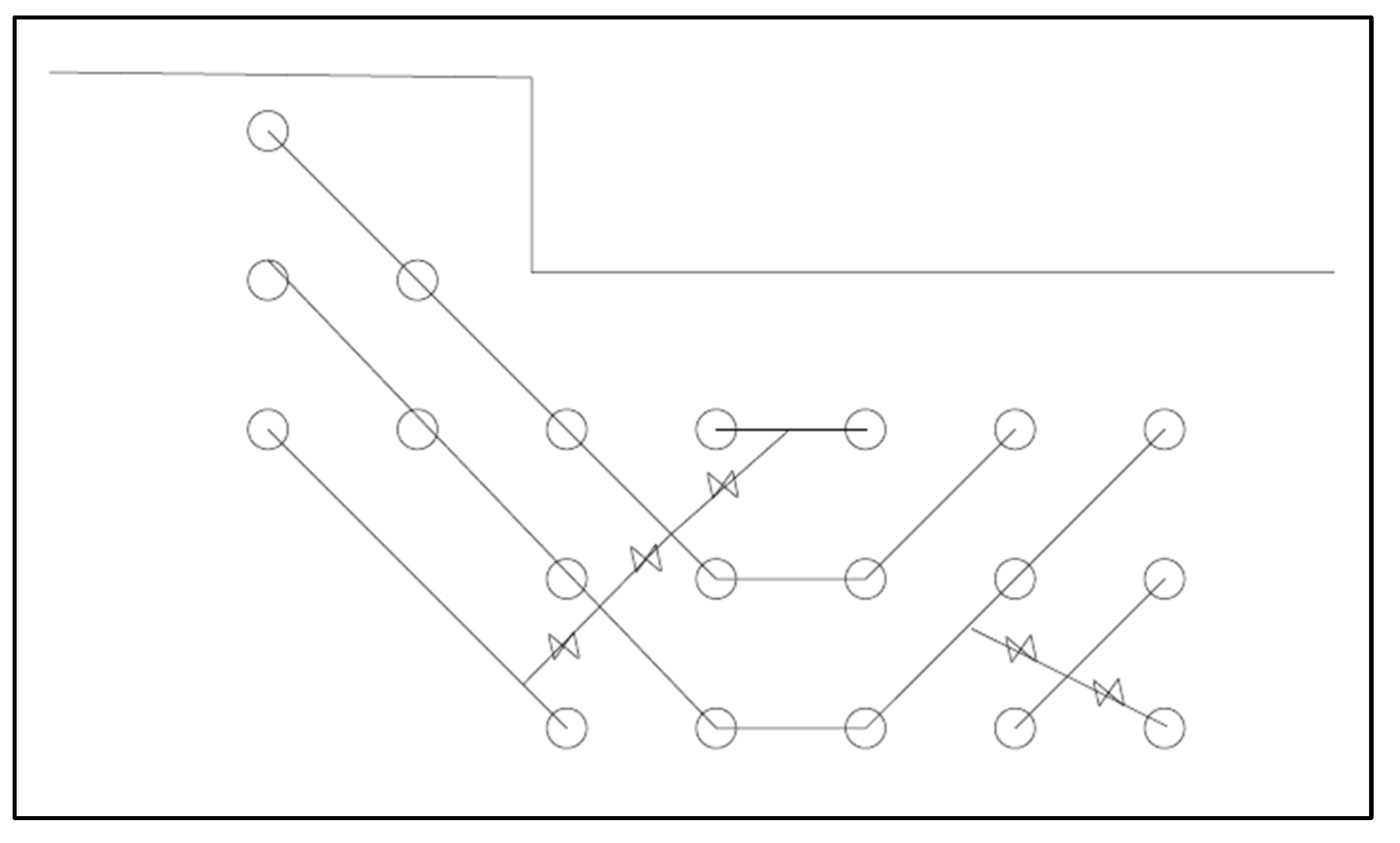

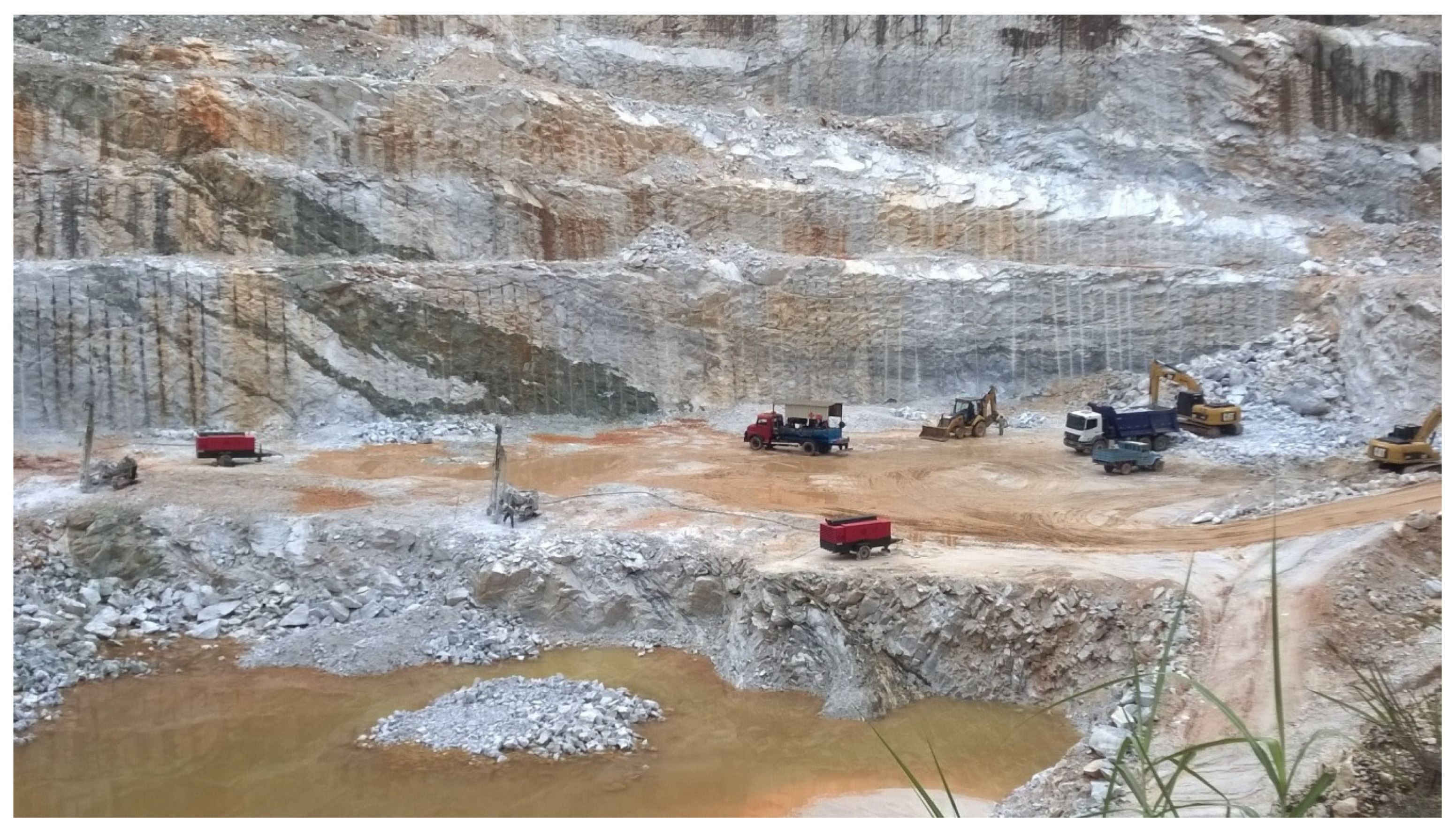




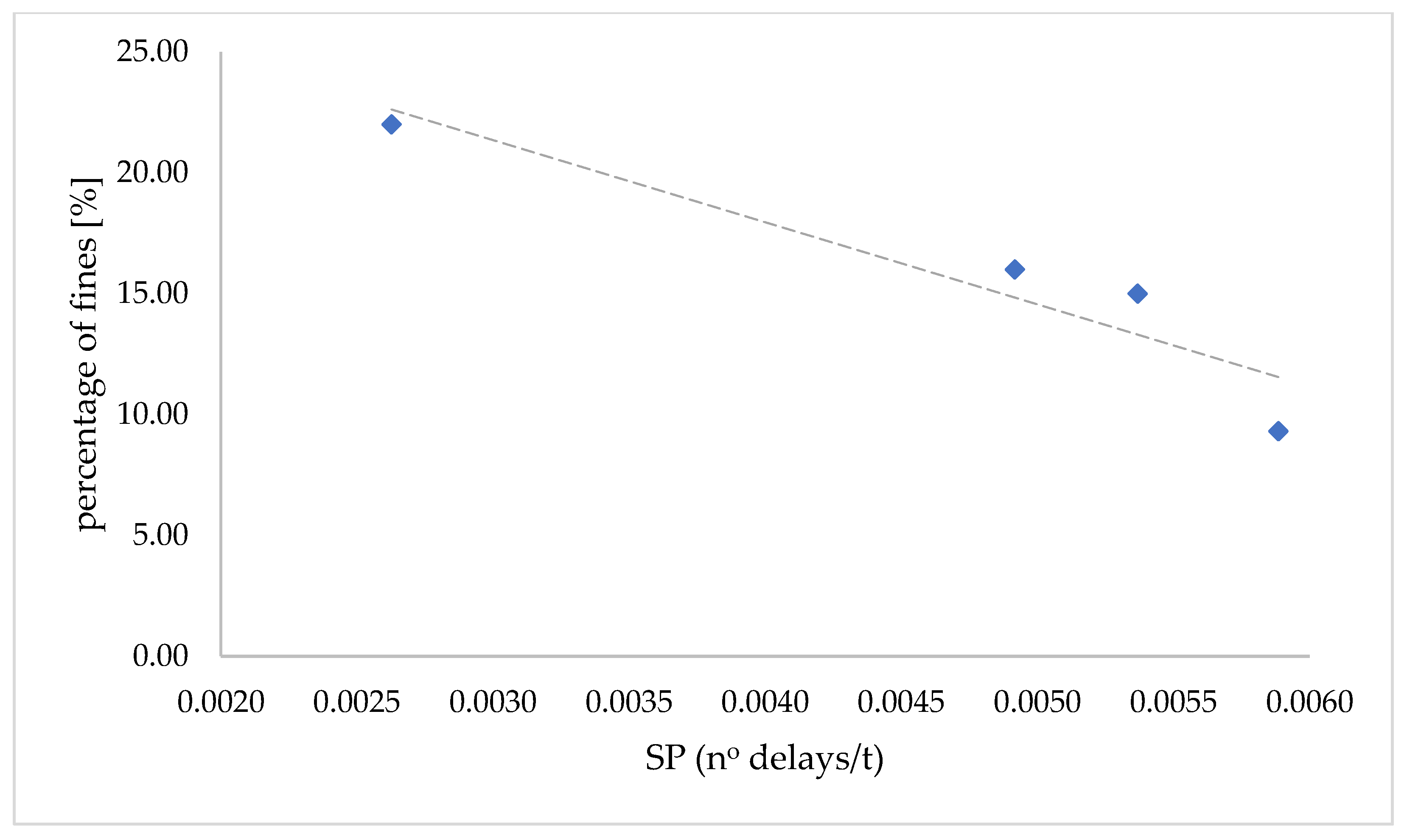
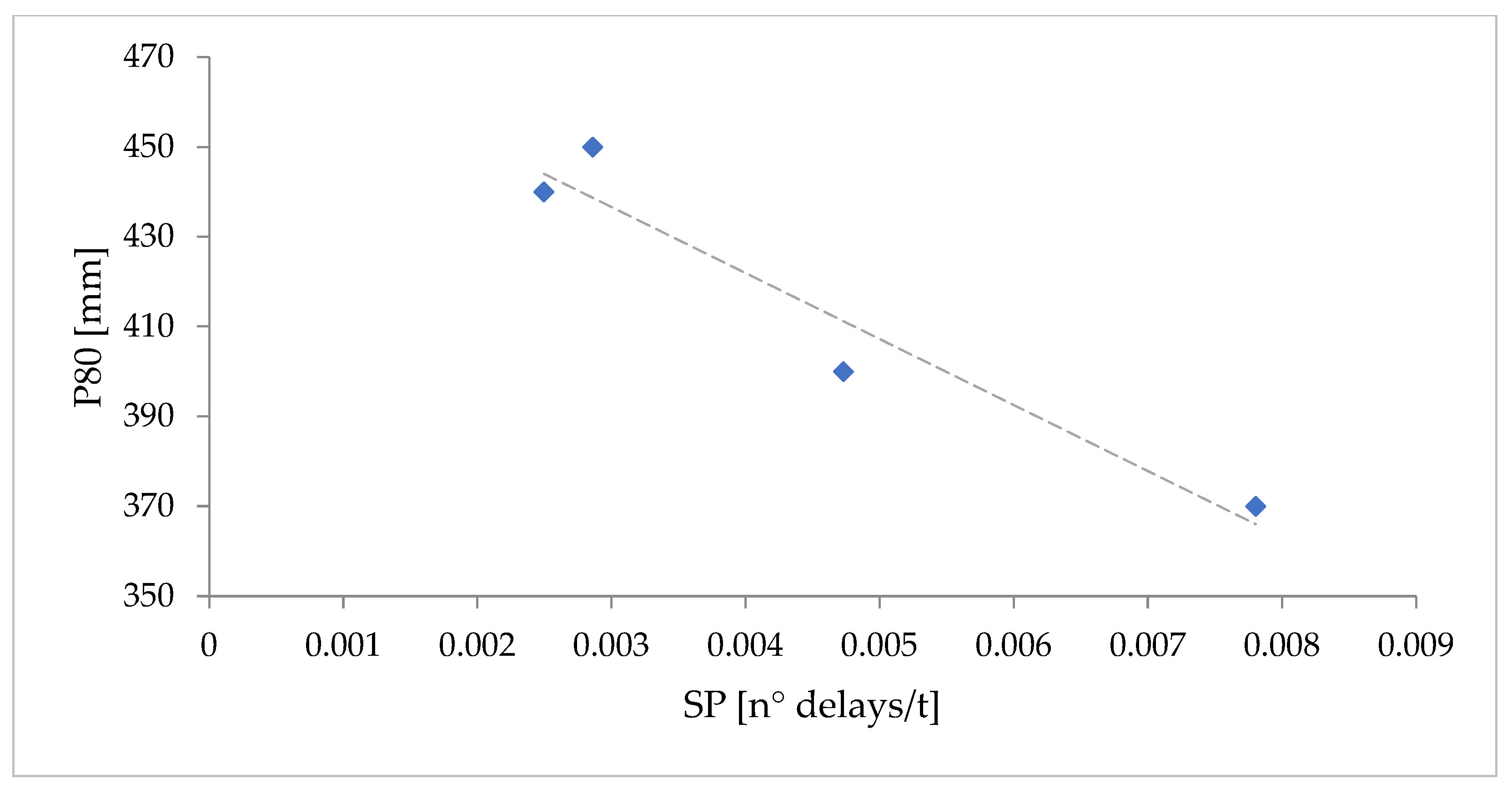

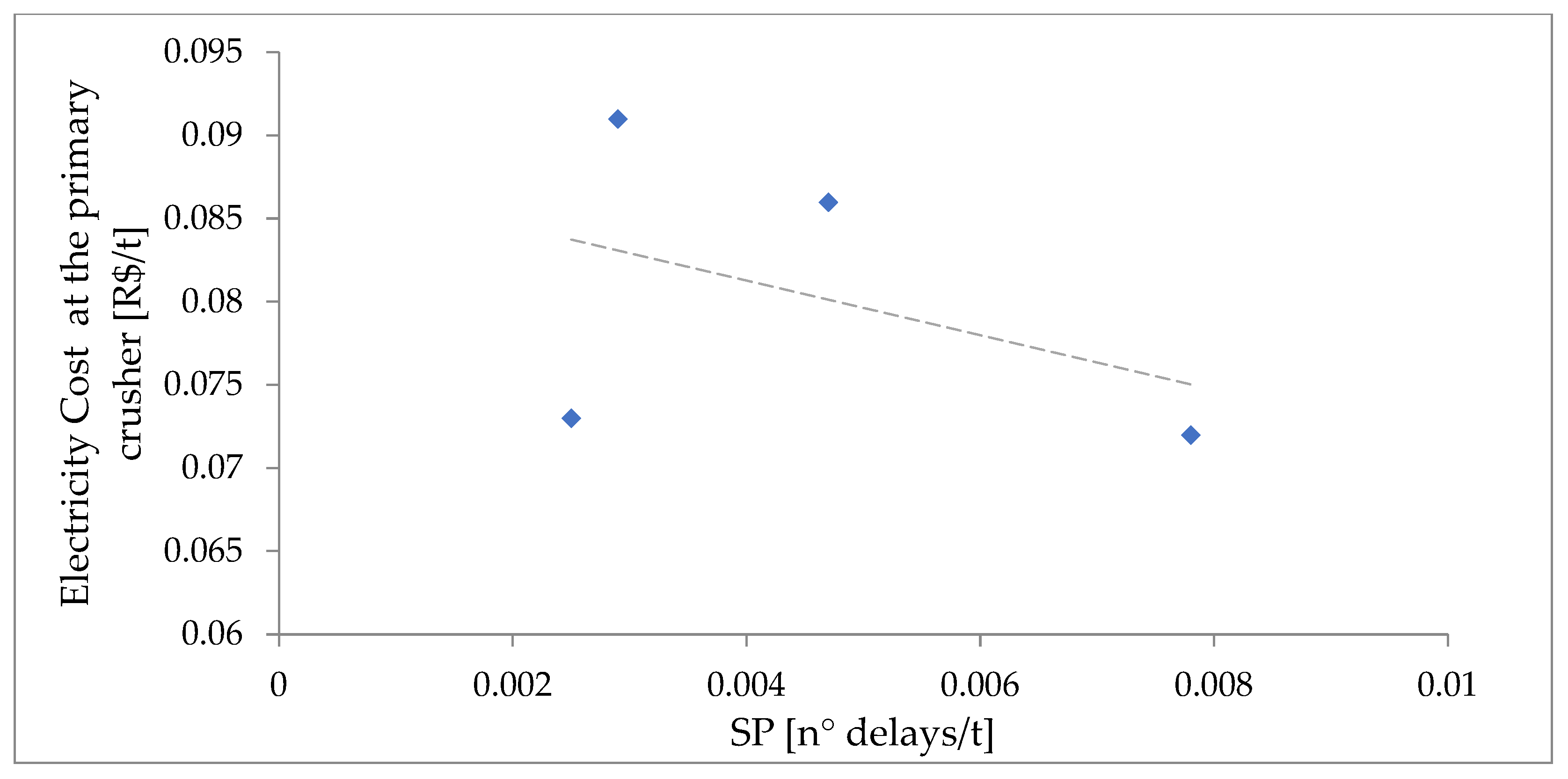
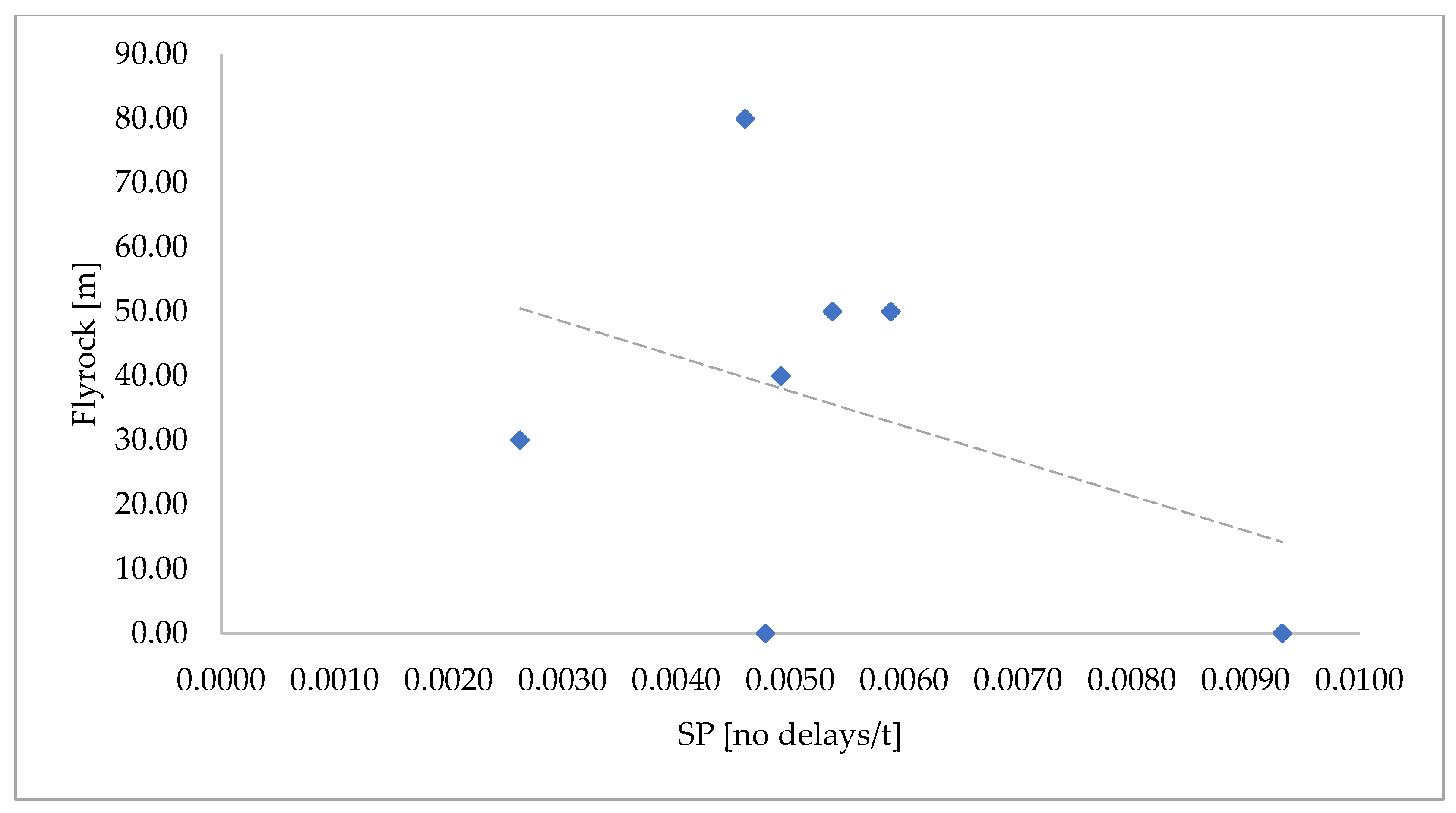
| Lithology | UCS [MPa] | Schmidt Hammer Rebound [mm] | Is50 [MPa] |
|---|---|---|---|
| Marble, large grain size | 71.6 | 50.8 | 4.6 |
| Marble, medium grain size | 63.8 | 43.6 | 2.5 |
| Banded marble | 42.2 | 49.4 | 2.6 |
| KPI | Description | |
|---|---|---|
| Specific incidence of secondary breaking | [h/m3] | The working time of the hydraulic hammer employed for secondary breaking, normalized to the volume of the bench before blasting. The good or bad outcomes of a blast in terms of particle size can be evaluated according to how many hours the hydraulic hammer has worked on a muckpile to reduce oversize blocks below the threshold size value. |
| Percentage of fines in the muckpile | The amount of material passing a mesh of 5 mm over the total amount of blasted material. | |
| Electricity cost at the primary crusher | The electricity consumption measured at the primary crusher via a direct electricity meter installed at the circuit feeding the engine, multiplied by the cost of kWh at the local electrical company. | |
| Passing size at 80% | [mm] | The passing diameter for 80% of the mass of the fragments resulting from the blast, obtained via photographical analysis. |
| Specific priming | SP [n°delay/t] | The density of delays per unit of mass of blasted rock, quantifying the impact of timing on the blast plan. |
| Flyrock | [m] | In this research, flyrock is defined as the distance at which the fragment traveled furthest beyond the position of the muckpile. The trajectory and landing positions of the flyrock fragments were observed via high-speed video analysis of the blast and resulting movement of the muckpile. |
Disclaimer/Publisher’s Note: The statements, opinions and data contained in all publications are solely those of the individual author(s) and contributor(s) and not of MDPI and/or the editor(s). MDPI and/or the editor(s) disclaim responsibility for any injury to people or property resulting from any ideas, methods, instructions or products referred to in the content. |
© 2024 by the authors. Licensee MDPI, Basel, Switzerland. This article is an open access article distributed under the terms and conditions of the Creative Commons Attribution (CC BY) license (https://creativecommons.org/licenses/by/4.0/).
Share and Cite
Seccatore, J.; Vigna, S.; Marin, T.; Cardu, M. The Role of Delays in the Performance of Blasting. Appl. Sci. 2024, 14, 4657. https://doi.org/10.3390/app14114657
Seccatore J, Vigna S, Marin T, Cardu M. The Role of Delays in the Performance of Blasting. Applied Sciences. 2024; 14(11):4657. https://doi.org/10.3390/app14114657
Chicago/Turabian StyleSeccatore, Jacopo, Stefano Vigna, Tatiane Marin, and Marilena Cardu. 2024. "The Role of Delays in the Performance of Blasting" Applied Sciences 14, no. 11: 4657. https://doi.org/10.3390/app14114657
APA StyleSeccatore, J., Vigna, S., Marin, T., & Cardu, M. (2024). The Role of Delays in the Performance of Blasting. Applied Sciences, 14(11), 4657. https://doi.org/10.3390/app14114657









